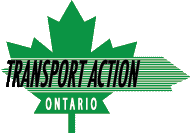By
Transport Action Ontario
|
Intercity Rail and Bus ,
Latest News
Background: After an analysis of available public information on VIA Rail Canada’s High Frequency Rail (HFR) proposal, Transport Action Ontario has issued the following statement:
Since our founding nearly 30 years ago, Transport Action Ontario (TAO) has strongly supported intercity passenger rail, as it provides many economic, social and environmental benefits to Canadians. The Windsor-Quebec corridor is the heart of Canada’s existing passenger rail system. TAO agrees with VIA Rail Canada’s ambition to triple the number of trains per day in the Toronto-Ottawa-Montreal-Quebec portion of this corridor, as well as improving on-time performance and reducing travel times.
One available option is VIA’s High Frequency Rail/dedicated track proposal (HFR). It envisions new dedicated northern trackage between Toronto-Ottawa (using the partially abandoned Havelock line)
and between Montreal-Quebec (using north shore trackage accessed through the Mt. Royal tunnel) , while improving the schedule on existing Lakeshore and South-shore routes. Maximum train speeds are planned as 160 kph.
The Federal Government (Transport Canada) is currently evaluating this and other proposals to add passenger rail capacity in this corridor.
TAO has met with VIA’s senior planning staff to discuss HFR and has analyzed the limited publicly available information on HFR, as well as other relevant comparable projects. We endorse VIA’s HFR objective, particularly the strategic benefit of dedicated tracks for passenger service. This benefit can be maximized if long segments of dedicated track are combined with increased attention to timely operation of passenger services where co-use with main line freight operations is required. We also concur with VIA that operation at typical “high speed rail“ speeds (250 kph+) has a poorer cost-benefit ratio than VIA`s proposed speed.
TAO looks forward to a fulsome public review of the details of HFR. Particularly important is a discussion on securing access to the Mt. Royal tunnel in view of the Montreal REM transit project and a discussion on the best planned maximum train speed (160 vs 200 kph).
We urge the Federal Government to move forward promptly and commit to boosting passenger rail frequencies, speeds and on-time performance in this corridor.
We also look forward to working with all stakeholders, especially VIA and Transport Canada, on how to achieve improved passenger rail service in the entire Windsor-Quebec corridor, including Southwestern Ontario.


